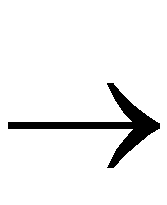
Asynchronous Mode Debugging
Asynchronous mode debugging allows you to use any external clock. Because the XChecker cable does not control the system clock, any number of clocks can occur between snapshots; thus, all snapshots are asynchronous to the system clock.
Pin Assignments
In asynchronous mode, you do not use the XChecker cable to control the clock; therefore, leave the XChecker CLKI and CLKO pins unconnected. Instead, you use an oscillator to drive the FPGA system clock directly. Connect the system clock so that it controls the target device flip-flops directly.
Debugging in the Asynchronous Mode
In asynchronous mode debugging, you use a free-running clock to cycle the device.
- Select Debug
 Asynchronous Mode or click the following toolbar button.
Asynchronous Mode or click the following toolbar button.

The Debug  Settings commands and the Debug Control Panel options, shown in the “Debug Control Panel (Asynchronous Mode)” figure, are enabled for asynchronous debugging.
Settings commands and the Debug Control Panel options, shown in the “Debug Control Panel (Asynchronous Mode)” figure, are enabled for asynchronous debugging.
NOTEBecause the Hardware Debugger does not control the system clock, the clock settings are disabled.
|
- Select Debug
 Settings
Settings  Trigger or click the Triggers button in the Debug Control Panel.
Trigger or click the Triggers button in the Debug Control Panel.
The Trigger command invokes the Asynchronous Trigger Settings dialog box, shown in the “Asynchronous Trigger Settings Dialog Box” figure, which enables you to select the type of trigger you want to initiate the readback.
- In the Trigger On list box, select External pin (active-High on the TRIG pin of the XChecker cable) or Enter Key to initiate a readback, or you can initiate a readback Immediately after the Read Snapshots command is invoked.
- Use the Timeout After option to specify the cutoff time for a trigger to be detected. If the trigger is not received within the specified time, the readback is canceled.
- Select Pulse RESET at First Snapshot to reset the device each time you execute the Read Snapshots command.
- After setting the desired trigger settings, click OK.
The Asynchronous Trigger Settings dialog box closes and the status bar displays the Trigger settings.
- Select Debug
 Settings
Settings  Display Signals or click Display in the Debug Control Panel to choose the signals and groups that you want to display.
Display Signals or click Display in the Debug Control Panel to choose the signals and groups that you want to display.
For details on how to select signals for display, see the “Creating and Modifying a Signal List” section in this chapter.
- Select Debug
 Reset FPGA or click Pulse /RESET on the Debug Control Panel whenever you need to reinitialize the device.
Reset FPGA or click Pulse /RESET on the Debug Control Panel whenever you need to reinitialize the device.
- Select Debug
 Read Snapshots to read the states of the signals that you selected for debugging or click Read in the Debug Control Panel.
Read Snapshots to read the states of the signals that you selected for debugging or click Read in the Debug Control Panel.
The device being read back returns its configuration data and the state of every probe point when a readback is triggered.
NOTEThe readback data stream is linked to the active waveform window only. After the connection is closed, the waveform window is not updated with new information.
| 
